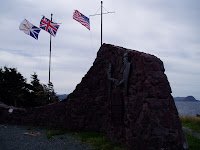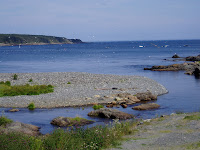Exploring....
 During the five days we have been staying at the Viking RV park just outside L'Anse aux Meadows we have explored many small settlements. From Rawley and Burnt Cape to Quirpon (rhymes with harpoon) and Hay Cove we have admired the beautiful coastline and tried the local food in small restaurants.
During the five days we have been staying at the Viking RV park just outside L'Anse aux Meadows we have explored many small settlements. From Rawley and Burnt Cape to Quirpon (rhymes with harpoon) and Hay Cove we have admired the beautiful coastline and tried the local food in small restaurants.Shops are set up to in a very upscale, slick manner to serve the hundreds of visitors from across the USA and Europe. One re-enactor at Norstead told us that on a regular summer day they will have between 300 to 400 visitors. At this time with the temperatures dropping and many days of rain, large buses full of tourists, rental cars and every type of camping unit can be seen in the parking lots and on the roads.
Saturday September 1st, we leave here to catch the ferry to Labrador.
Our photos;
-



















































